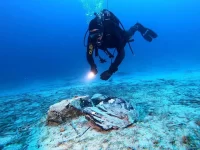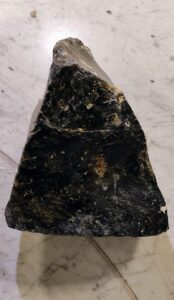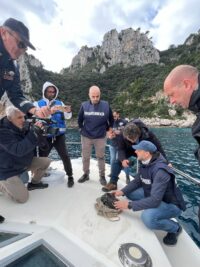 Maritime archaeologists have recovered a block of worked obsidian from a Neolithic shipwreck off the coast of Capri, Italy. Archaeologists from the Superintendency for the Metropolitan Area of Naples recovered the first of a group of worked obsidian cores in a dive on Monday, November 20th. The presence of obsidian blocks in the area had been reported by divers in 2012, but not the specific location. They were located in October near the famous White Grotto of Capri by an underwater unit of the Naples police, and a month later the site was explored by maritime archaeologists.
Maritime archaeologists have recovered a block of worked obsidian from a Neolithic shipwreck off the coast of Capri, Italy. Archaeologists from the Superintendency for the Metropolitan Area of Naples recovered the first of a group of worked obsidian cores in a dive on Monday, November 20th. The presence of obsidian blocks in the area had been reported by divers in 2012, but not the specific location. They were located in October near the famous White Grotto of Capri by an underwater unit of the Naples police, and a month later the site was explored by maritime archaeologists.
 The block they recovered measures approximately 11 by 8 by 6 inches and weighs almost 18 pounds. It bears traces of chiseling and processing, which is how archaeologists know it was trade material, not a random chunk of obsidian that made its way to the seabed on its own.
The block they recovered measures approximately 11 by 8 by 6 inches and weighs almost 18 pounds. It bears traces of chiseling and processing, which is how archaeologists know it was trade material, not a random chunk of obsidian that made its way to the seabed on its own.
No remains of a ship were found, but the dispersal area of the obsidian was much larger than reported and at a depth of between 100 and 130 feet. That indicates the blocks were the cargo of a lost ship. The
Superintendency is planning an extensive instrumental survey of the seabed to look for the possible hull and any other cargo material around the find site.
The obsidian block was transferred to a warehouse of the Superintendency and awaits cleaning and conservation. Conservators will remove the concretions on its surface to analyze the block in detail.
 It was in the Neolithic that obsidian began to be used to create sharp weapons and cutting tools. It chips as easily as flint, but creates a sharper edge. In the late 19th century, a major cache of obsidian blocks and more than 800 finished obsidian objects was discovered on a private estate in Capri. They were the remains of a 7,000-year-old obsidian cutting workshop. Recent analyses of those obsidian materials determined they originated in Lipari, a volcanic island in the Aeolian Archipelago north of Sicily whose rich obsidian flows were extensively quarried by Neolithic communities. The presence of Lipari obsidian in Capri is evidence there was an active trade over land and sea.
It was in the Neolithic that obsidian began to be used to create sharp weapons and cutting tools. It chips as easily as flint, but creates a sharper edge. In the late 19th century, a major cache of obsidian blocks and more than 800 finished obsidian objects was discovered on a private estate in Capri. They were the remains of a 7,000-year-old obsidian cutting workshop. Recent analyses of those obsidian materials determined they originated in Lipari, a volcanic island in the Aeolian Archipelago north of Sicily whose rich obsidian flows were extensively quarried by Neolithic communities. The presence of Lipari obsidian in Capri is evidence there was an active trade over land and sea.
*Sigh* – Neolithic Mediterranean islands –i.e. the ones in ‘Mare Nostrum’– must have been an interesting environment –i.e. with dense forests, no cars in jams whatsoever– and dwarfed(!) hippos and elephants.
‘Palaeoloxodon falconeri’, for example, is an extinct species of dwarf elephant from Sicily and Malta. It is amongst the smallest of all dwarf elephants at only 1m (3.3ft) in height.
“Rekhmire” was an ancient Egyptian official of the 18th Dynasty, who served as “Governor of the Town” (Thebes) and Vizier during the reigns of Thutmosis III and Amenhotep II, in circa 1400 BC.
His grave sports a painting with an absolutely tiny elephant –like a dog on a leash– but with massive tusks: “Syrians bringing presents in the tomb of Rekhmire” 🐘️
—
“Dwarf elephants first inhabited the Mediterranean islands during the Pleistocene, including all the major islands with the apparent exception of Corsica and the Balearics.
It has been suggested that the skulls of such elephants sparked the idea that they belonged to giant one-eyed monsters, because the center nasal opening was thought to be the socket of a single eye.”
—